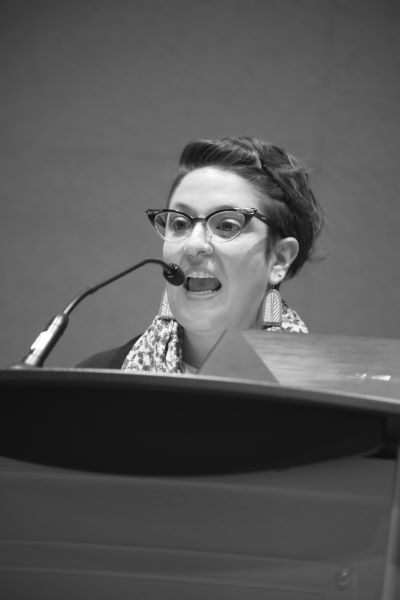by Dorothy Rice
This post is part of a HippoCamp 2021 recap series, with guest blog posts written by HippoCamp attendees. Learn more about our conference for creative nonfiction writers.

Rae Pagliarulo giving her flash presentation at HippoCamp 2021. Photo by Lina Seijo for Hippocampus Magazine.
Rae Pagliarulo’s flash session on what she, as Hippocampus flash editor, and her team of readers, are looking for in flash submissions, laid it out in five easy, digestible bites. Seriously. I’ve read books on how to write compelling flash. I’ve attended other talks on how to keep your flash from becoming a flash in the pan (er, slush pile). I’ve written some compact stories that maybe worked, and many more that didn’t, without grasping why they did, or didn’t. At HippoCamp 21, in ten short minutes—including entertaining asides—Rae laid it out in clear and succinct fashion. Her advice finally penetrated my ear canals and lodged in my brain, the all-important thinking, internalizing, ideally-turning-thoughts-into-words-on-the-page part of my brain (I’m not sure what that part is called; but I’m pretty sure it’s close to the hippocampus.)
Perhaps the flash format of the flash session was the perfect vehicle for this intel. Perhaps Rae is just really good. I’m thinking both are true. It’s so easy, especially at conferences, to get lost in the torrent of sessions, finding the bathrooms, speakers and slides and, before you know it, you’re doodling amoeba all over the program and wondering if you want a fruit smoothie, fruit salad, or maybe black cherry ice cream. One thing you know for sure; you want fruit.
As my grandkids always say, “Side-tracked, again.” They’re even and nine, by the way.
So here’s the beef, the gist, the straight skinny, the five key elements of successful flash:
- Economy of language
- Relationship clarity (who are the characters; don’t make the editor guess)
- The situation and the story (what’s it about? Ideally there’s what it’s about/what’s at stake, and also some universal truth)
- Use specifics (specific details make it universal)
- Strong open, strong close (ground us in the situation immediately; the ending should feel satisfying and appropriate)
Rae said (at least this is what I scribbled in my notebook), “The best endings are ones that are already evolving towards a new beginning.” She advised against the “ta-da!” or big-red-bow ending where everything is tied up tidy as the plot of a Hallmark movie (not that there’s anything wrong with Hallmark movies).
It’s tempting to think that any short piece of prose can work as flash, that it’s just a matter of word count (300, 500, 750, 100 words—read those submission guidelines!). It’s so much more than that. As with any story that matters, flash CNF must involve a journey, a transition or transformation, some movement or shift—no matter how minor. And there’s the vexing question of “why?” Why did you write this? Why do you (the writer) want to tell me (the editor) this? That “why” question is, in my experience, one that so often trips us writers up. It’s a cool story, a fun anecdote, a traumatic moment … yeah, yeah, but why are we telling it, and why now?
Rae made the essential elements clear and she did so as one might create a flash piece. Strong open and close—check. Specific details as examples—check. The situation and the story—check (she’s the flash editor; which also goes to relationship clarity). Economy of language—double check. What’s at stake—your precious baby’s fate in the slush pile.
I now see that this post violates many (most) of her excellent guidance. I meandered. Economy of language—through the roof. And geez, why bring the grandkids into it? I did use some specific details—black cherry ice cream! So good. Though I’m so often disappointed by the paucity of cherry chunks.
One last note: there are no doodles or food smudges on the two pages where I took notes on this session. I was paying attention.
 Dorothy Rice is the author of the memoirs, GRAY IS THE NEW BLACK (Otis Books, June 2019) and THE RELUCTANT ARTIST (Shanti Arts, 2015) and the editor of the anthology TWENTY TWENTY—43 Stories From A Year Like No Other. After raising five children and retiring from a career managing statewide environmental protection programs, Rice earned an MFA in Creative Writing from UC Riverside, Palm Desert, at 60. Dorothy co-directs the literary series Stories on Stage Sacramento, conducts creative writing workshop for 916 Ink, a youth literacy nonprofit, is the new managing editor of Under the Gum Tree.
Dorothy Rice is the author of the memoirs, GRAY IS THE NEW BLACK (Otis Books, June 2019) and THE RELUCTANT ARTIST (Shanti Arts, 2015) and the editor of the anthology TWENTY TWENTY—43 Stories From A Year Like No Other. After raising five children and retiring from a career managing statewide environmental protection programs, Rice earned an MFA in Creative Writing from UC Riverside, Palm Desert, at 60. Dorothy co-directs the literary series Stories on Stage Sacramento, conducts creative writing workshop for 916 Ink, a youth literacy nonprofit, is the new managing editor of Under the Gum Tree.

